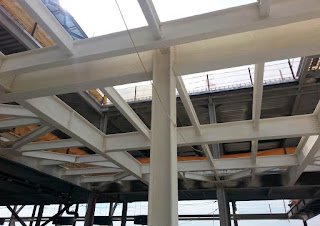All buildings have to serve two
important functions. They have to carry the loads (structural requirement) and
provide livable environment to the occupants to enable them to be comfortable
in the use of the building (functional requirement).
The building has to carry its own
weight and external occupancy loads and those caused by the environment such as
those caused due to wind or earthquake. The elements that bear these loads and
transmit them to the foundation are termed as “structural elements”. A good
performance of the structural elements such as beams and columns is of vital
importance from the safety and stability points of view. Hence, they are
designed and constructed with prescribed safety margins as per requirements
specified in the Bureau of Indian Standard specifications. Their failure will
cause cracking, yielding of steel and even ultimate collapse of the building.
The serviceability of a building
depends on the good performance of the structural and the functional elements
such as flooring, doors and windows, glass panels and partition walls. The
functional elements are generally not intended to carry structural loads. Their
failure to perform will only affect the use of the building and not its
strength or stability. Their good performance is also equally important.
In a metropolitan city such as
Chennai, most apartment buildings are made of reinforced concrete frames. In
this type of construction, the structural elements comprise beams and columns
which carry the loads. The partition walls and infill walls in these buildings
are treated as non-structural and hence are not generally designed and
constructed to carry structural loads. In such buildings, for good performance
it is necessary to detail the junction structural and non-structural members
with proper care. The deformation of the structural members under load should
not be restricted by non-structural partitions or in-fills.
For good performance of both beams
and partitions, a proper sequence of construction is essential. First building
the infill or partition and that casting the concrete beam on top will make the
dead weight of the concrete beam load the partition which is not correct. The
partition is not supposed to carry the weight of the beam. Moreover, when the
additional live load comes on the floor the deflection of the beam will crack
the brick infill or partition.
To avoid this problem, first the
frame should be completed. This should be followed by the erection of
partitions and in-fills. Care should be taken to see that a structural gap
exists between the frame and the in-fill. For functional convenience this gap
can be filled by inert flexible material such as thermocol or pith.
Under no circumstance a structural
member should be cut or chased or damaged in any way for any purpose including
for taking services like electrical conduits, concealed wiring etc. This will
weaken the element and may cause its collapse leading to the collapse of the
whole building. However the services may be taken through the non-structural
partitions or infills.
Bearing walls
This type of construction is
undertaken in semi-urban and rural areas.
All the main walls carry loads and also serve to provide functional
requirement. In these buildings, though the partition walls do not carry structural
loads, they cannot be either built or demolished without due consideration for
overall stability of the building. Some times their weight may be required to
provide stability against overturning failure. The main walls invariably
provide the structural stability and carry loads. Hence, they cannot be damaged
or dismantled for carrying conduits for electricity, etc.
Bearing wall buildings though safe
for vertical loads are weak under lateral loads. They are vulnerable for
failure under out of plane bending during lateral loading. Therefore, to make
the building act as one integral unit, they should be constructed with
continuous plinth and continuous lintel beams. No brick pillar should be less
than 600 mm in width. All openings should be reinforced on all sides. These
simple precautions will ensure good performance of bearing wall buildings under
lateral loads caused by wind or earthquakes.
In many sites the brick wall is
first raised and then used as shuttering to cast the column or beam adjoining
it. This will make the column or beam weak because the pores in brickwork will
absorb the moisture from wet concrete making the w/c ration in the beam and
column uncertain. The weakness will manifest in the cover concrete of the beam
or column, leading to early onset of corrosion in the rebars.
The cracking in the walls of the
buildings are many times attributed to following wrong constructions practices.
It is important to pay attention to the details at the site of construction to ensure
long and trouble free service of the infrastructure created. A conscious
distinction should be made between the structural and non-structural items in a
building and their requirements and performance. These defects when permitted
during construction are difficult and costly to rectify later.
For More...........:

No comments:
Post a Comment